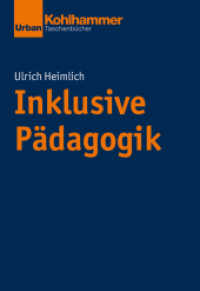Full Description
This edited book explores the use of technology to enable us to visualise the life sciences in a more meaningful and engaging way. It will enable those interested in visualisation techniques to gain a better understanding of the applications that can be used in visualisation, imaging and analysis, education, engagement and training.
The reader will be able to explore the utilisation of technologies from a number of fields to enable an engaging and meaningful visual representation of the biomedical sciences, with a focus in this volume related to anatomy, and clinically applied scenarios.
The first six chapters in this volume show the wide variety of tools and methodologies that digital technologies and visualisation techniques can be utilised and adopted in the educational setting. This ranges from body painting, clinical neuroanatomy, histology and veterinary anatomy through to real time visualisations and the uses of digital and social media for anatomical education. The last four chapters represent the diversity that technology has to be able to use differing realities and 3D capture in medical visualisation, and how remote visualisation techniques have developed. Finally, it concludes with an analysis of image overlays and augmented reality and what the wider literature says about this rapidly evolving field.
Contents
Chapter 1. Enhancing teaching in biomedical, health and exercise science with real-time physiological visualisations (Christian Moro, Zane Stromberga & Ashleigh Moreland).- Chapter 2. The evolution of educational technology in veterinary anatomy education (Julien Guevar).- Chapter 3. Body Painting Plus: Art-based activities to improve visualisation in clinical education settings (Angelique N. Dueñas & Gabrielle M. Finn).- Chapter 4. TEL methods used for the learning of clinical neuroanatomy (Ahmad Elmansouri, Olivia Murray, Samuel Hall, Scott Border).- Chapter 5. From Scope to Screen: The Evolution of Histology Education (Jamie A. Chapman, Lisa M.J. Lee and Nathan T. Swailes).- Chapter 6. Digital and Social Media in Anatomy Education (C. M. Hennessy and C. F. Smith).- Chapter 7. Mixed and Virtual Reality Interaction and Presentation Techniques for Medical Visualizations (Ross T. Smith, Thomas J. Clarke, Wolfgang Mayer, Andrew Cunningham, Brandon Matthews, Joanne E. Zucco).- Chapter 8. Pores, pimples and pathologies: 3D capture and detailing of human skin for 3D medical visualisation and fabrication (Mark Roughley).- Chapter 9. Extending the reach and task-shifting ophthalmology diagnostics through remote visualisation (Mario E Giardini and Iain A T Livingstone).- Chapter 10. Image overlay surgery based on augmented reality: A systematic review (Laura Pérez-Pachón, Matthieu Poyade, Terry Lowe, Flora Gröning).








